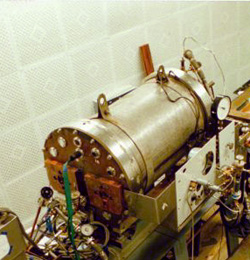Two Photons Diverged

If a fat man walked into an empty room and then two skinny guys walked out, you might be perplexed. Now physicists have spotted the equivalent result in photons flying near an atom. A group publishing in the 5 August print issue of PRL has identified rare instances in which a single photon splits in two, dividing the original photon’s energy between them.
Fundamental particles constantly and randomly morph into “virtual” particles. A photon, for example, can temporarily become an electron and positron which quickly annihilate one another to reform the original photon. In a vacuum the process has little effect, but the electric field of an atom can interact with electron-positron pairs to create theoretically measurable results, some of which have already been fingered. One such event, which researchers had sought for decades, is photon splitting. In unrelated experiments, physicists studying quantum optics often create pairs of photons from single, higher energy photons by hitting a special crystal with laser light, but that process involves exciting the crystal’s atoms. In photon splitting, a photon first transforms into an electron-positron pair; then one of those particles emits a photon before annihilating with its partner to produce the second photon.
In 1995, a team at the Budker Institute of Nuclear Physics (BINP) in Novosibirsk, Russia, made the first observation of photon splitting, and they announced preliminary results at two conferences. Now they have completed their full analysis of the data, which turned up more splitting events than before and allowed them to compare the predictions of exact quantum field theory with the conventional approximation.
The team used highly energetic gamma rays (photon energies between 100 and 450 MeV), which they produced by colliding infrared photons head-on with a high-energy electron beam. These pumped up photons were less likely to engage in interactions that would have obscured detection of the split photons. The high energy beam passed through a bismuth germanate crystal target into detectors, and the group looked for photon pairs whose total energy tallied up properly. Of 1.6 billion photon hits, only around 400 fit the bill. The rarity of the event means “this is an extremely difficult experiment,” says co-author Alexander Milstein of the BINP. The results agreed with the exact theory but demonstrated that the so-called Born approximation overestimates the likelihood of photon splitting by 20%.
Splitting is one of several of the more complicated behaviors photons can exhibit on rare occasions, says Martin Schumacher of the University of Goettingen in Germany. For instance, one photon scattering off of another hasn’t yet been seen. Quantum field theory being what it is, nobody doubted that photon splitting should exist, he says. “But fundamental processes should be observed before they can be considered as part of our knowledge.”
–JR Minkel
JR Minkel is a freelance science writer in New York City.


